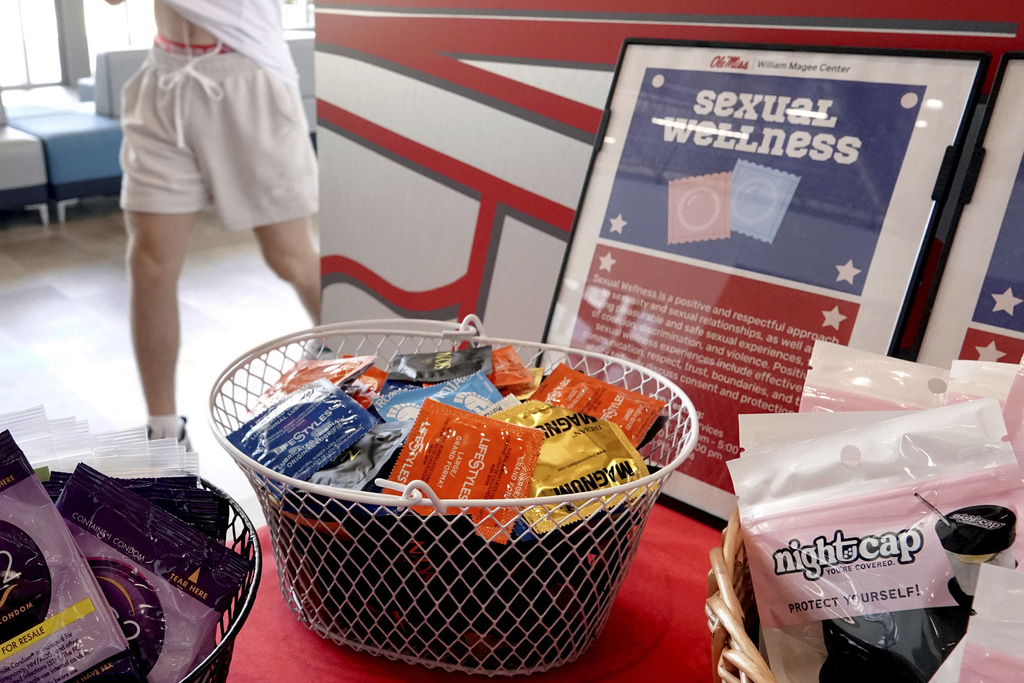Condom Usage Declines Among Youth Despite Rising STI Rates \ Newslooks \ Washington DC \ Mary Sidiqi \ Evening Edition \ Condom use is on the decline among young people, despite rising STI rates. Medical advancements, reduced fear of HIV, and limited sex education are influencing this trend. Public health experts are rethinking strategies to promote safer sex and STI awareness in younger generations.

Changing Attitudes Toward Condom Use Among Youth: Quick Looks
- Decline in Condom Use: Fewer young people are using condoms, leading to increased STI risks.
- Condom Bowl at Ole Miss: Despite condom availability, few students at the University of Mississippi take them.
- Medical Advancements: Long-term birth control methods and PrEP are contributing to a decline in condom usage.
- Changing Motivations: Reduced fear of HIV is shifting priorities away from condom use.
- Role of Sex Education: Varied levels of sex education impact attitudes; abstinence-only education prevails in some areas.
- Social Pressures: Young women report challenges convincing partners to use condoms during casual sex.
- New STI Prevention Drugs: Doxy PEP, a new drug, is gaining popularity for preventing STIs post-exposure.
- Public Health Response: Experts focus on promoting safe sex practices tailored to young people’s changing attitudes.
Deep Look
At the entrance to the gym at the University of Mississippi, a large bowl of condoms sits overflowing—noticeable, yet largely ignored. Some students walking past after their workout snicker, others point, and a few step forward before reconsidering and turning away when their friends catch up, laughter trailing behind them. The condoms seem untouched, even though university officials claim they refill the bowl multiple times daily and make them available at various campus locations.
This apparent disinterest in condoms is reflective of broader shifts in sexual attitudes among young people today. Despite the fact that condoms remain a highly effective tool for preventing sexually transmitted infections (STIs) and unwanted pregnancies, fewer young people are using them, and fewer are sexually active in general. Those who are sexually active often opt out of using condoms altogether. According to public health data, people aged 15 to 24 accounted for half of new chlamydia, gonorrhea, and syphilis cases in 2022, and these rising rates coincide with a decline in condom usage.
The reasons behind this downward trend in condom use are complex and multifaceted. Advancements in long-term birth control options, the rise of drugs like PrEP (which prevent HIV), and varying degrees of sex education have all contributed to changing behaviors. As a result, public health experts are rethinking how to help younger generations stay safe, emphasizing both awareness of available options—including condoms—and the importance of regular STI testing.
“Old condom ads were meant to scare you, and all of us were scared for the longest time,” said Dr. Joseph Cherabie, medical director of the St. Louis HIV Prevention Training Center. “Now we’re trying to move away from that and focus more on what works for you.”
The shifting attitudes toward condoms were evident in Oxford, Mississippi, the day before the first football game of the season, when the town was buzzing with excitement. College students gathered downtown, queued outside bars, and leaned on each other, reveling in the atmosphere of the new school year. But according to Magan Perry, president of the Public Health Student Association at Ole Miss, many of those students likely did not use a condom during their sexual encounters. “Using a condom is just a big, ‘uh, no,’” she said.
Perry noted that young women often have to be the ones to initiate the use of condoms, a challenging position to be in, as they face reluctance and even resistance from their partners. She’s heard stories of men dismissing the need for condoms, suggesting they could simply buy emergency contraception the next day. “I’ve had friends who go home with a guy and say they’re not having sex unless they use a condom, and immediately the reaction is either a reluctant, ‘OK, fine,’ or ‘If you don’t trust me, then I shouldn’t even be here,’” Perry said. “They’re like, ‘Well, I’m not dirty, so why would I use them?’”
According to Cherabie, the burden of preventing both pregnancy and STIs has often fallen on women, and buying contraceptives, like condoms or emergency contraception, can be uncomfortable and stigmatizing. For many young people, such experiences are filled with shame, which can deter them from taking proactive steps to protect themselves.
Annie Loomis, a student at the University of Washington, agreed that the rise of dating apps and casual hookups has made it more difficult for people to understand what a “healthy sexual relationship” entails in terms of intimacy and respect. “If you say, ‘Hey, I want you to wear a condom,’ and they say, ‘No, I don’t,’ you’re not having sex. It should be that simple,” Loomis said. “But it’s not.”
Condom use in the LGBTQ+ community has also experienced a shift, particularly among men who have sex with men. During the height of the AIDS epidemic in the 1980s and early 1990s, condoms were critical for protection against HIV. But as medical advancements, like PrEP, became widely available, the fear of contracting HIV diminished, and condom use began to wane. Grindr, a popular gay dating app, even lists condom use as a “kink” rather than a health precaution, a change that concerns experts like Steven Goodreau, an HIV expert at the University of Washington. Goodreau is worried that changing attitudes among older populations are influencing younger generations, leading to a decline in condom use.
“Part of what we have to talk about is that there is something enticing about having condomless sex,” said Andres Acosta Ardilla, a community outreach director at an Orlando-based nonprofit focusing on HIV in the Latino community. “And we have to, as people working in public health, plan for the fact that people will choose to have condomless sex.”
One of the key shifts affecting condom use is the rise of alternative medical options. Young women are increasingly turning to long-term birth control options like intrauterine devices (IUDs) or birth control pills, which eliminate the need for condoms to prevent pregnancy. As relationships become more committed, couples tend to rely more on these methods, leaving condom use in the past.
Madeline Webb, a junior at Ole Miss, says she and her partner seem like exceptions to the trend—they have been together for four years but still use condoms, sharing the responsibility of buying them. “People see condoms as an inconvenience, but they do serve a purpose even if you’re on birth control because there is always a chance of an STD,” Webb said.
Another recent medical advancement gaining popularity is doxycycline post-exposure prophylaxis (or doxy PEP), a drug that can be taken within 72 hours after unprotected sex to prevent chlamydia, gonorrhea, and syphilis. Though it still requires a prescription, it’s gaining traction in the community of men who have sex with men and among transgender women. For many, doxy PEP represents an additional layer of protection beyond PrEP, offering further peace of mind regarding sexual health.
But the decline in condom use also points to significant gaps in sex education. In Mississippi, where the University of Mississippi is located, condom demonstrations are banned in public schools, and school districts only offer abstinence-only or “abstinence-plus” sexual education. These programs are limited in scope, often discussing condoms only briefly and discouraging their use. “The obvious consequence is the rise of sexually transmitted infections, which is what we’re seeing right now,” said Josh McCawley, deputy director of Teen Health Mississippi, an organization working to improve youth access to health resources.
Mississippi has the highest teen birth rate in the country, according to the latest CDC data, and inadequate sex education is a major contributing factor. In contrast, states like Oregon have implemented comprehensive sex education standards that provide students with medically accurate information, including how to use condoms effectively. In Portland, students are taught how to put on a condom using a model, and free condoms are available at most high schools.
The differences between states highlight the inconsistencies in sex education nationwide. According to Michelle Slaybaugh, director of social impact and strategic communication for the Sexuality Information and Education Council for the United States, there is no national standard for sex education, resulting in vast disparities in the quality and content of information provided to students. “We would never send a soldier into war without training or the resources they need to keep themselves safe,” Slaybaugh said. “So why is it OK for us to send young people off to college without the information that they need to protect themselves?”
The decline in condom use reflects changing attitudes, growing options for STI and pregnancy prevention, and significant gaps in education. For public health experts, the challenge lies in finding new ways to communicate the importance of safe sex to a generation that may no longer see condoms as a necessity. While medical advancements like PrEP and doxy PEP provide valuable options, condoms remain an accessible, on-demand tool that can play an important role in reducing STI rates if used consistently and correctly.
Condom Usage Condom Usage Condom Usage







